Nets4Learning: A Web Platform for Designing and Testing ANN/DNN Models
Abstract
1. Introduction
- Programming libraries such as Scikit-learn https://scikit-learn.org/stable/ (accessed on 30 October 2024), TensorFlow https://www.tensorflow.org/ (accessed on 30 October 2024) or Keras https://keras.io/ (accessed on 30 October 2024). Obviously, these tools require advanced programming skills, in addition to those specific to the AI tasks and techniques to be worked with. Like any other type of libraries, they need to be downloaded to the computer. It should be noted that these tools allow working with neural networks and other classic ML techniques. In comparison, although Nets4Learning is only focused on neural network techniques, our platform does not require programming skills, nor does it require the user to install any software. In addition, Nets4Learning has many built-in aids for both learning how neural networks work and how to design them. It should also be highlighted that the presented platform has graphical tools for pre-processing data, managing models or displaying results, tasks that can have high learning curves in the mentioned libraries.
- Local frameworks such as RapidMiner https://altair.com/altair-rapidminer (accessed on 30 October 2024), WEKA https://ml.cms.waikato.ac.nz/weka/ (accessed on 30 October 2024) or Orange https://orangedatamining.com/ (accessed on 30 October 2024). This next group of tools already has a graphical interface, so generally, no programming knowledge is required. They usually allow you to work with different types of tasks and techniques, but the support for a wide variety of options usually means that using these tools is quite complicated unless you have significant knowledge in different areas of AI. They need to be installed locally, which can mean the use of a PC with a certain storage capacity, computing costs, etc. Regarding Nets4Learning, although it is possible to work on different tasks, it only deals with neural networks, a widely used technique in the AI paradigm. Furthermore, the platform presented does not require installation and can be used on a wide range of devices (PCs, tablets, smartphones, etc.) without any special software or hardware requirements. Finally, compared to the tools in this group, Nets4Learning stands out for its usability and ease of use.
- Web repositories of pre-trained AI models such as TensorFlow Hub https://www.tensorflow.org/hub (accessed on 30 October 2024), HuggingFace https://huggingface.co/ (accessed on 30 October 2024) or NVIDIA NGC https://catalog.ngc.nvidia.com/ (accessed on 30 October 2024). This group of tools may be the most similar to Nets4Learning as they have access via a web platform as a common factor. However, most AI models of these web repositories need to be downloaded and integrated into the user specific application, which also implies important programming skills and hardware requirements. With Nets4Learning, all these skills are not necessary since it is a web application accessible from any device without specific requirements from the side of the user. It is true that in some platforms, like HuggingFace, the user may directly test some pre-trained model for some specific tasks, but unlike our application, it does not allow the user to design the topology or architecture of the neural network. These types of platforms also lack manuals, glossaries, etc., or other learning resources that are available on Nets4Learning.
2. Materials and Methods
2.1. Neural Networks
2.2. Nets4Learning
- Select Dataset: The user can select a pre-charged dataset or upload a new one from his/her device. After that, the different characteristics and their values of the chosen dataset can be inspected. Even some pre-processing techniques, such as standard or max–min scaler, can be applied to the dataset.
- Layer Design: At this stage, the user can thoroughly define the topology of the network to be designed. In this way, the number of layers of the network, the number of neurons for each layer, their activation function, etc., can be chosen.
- Hyperparameter Editor: The user can then set the main hyperparameters that define the network training process, such as learning rate, epochs, optimizer, loss function, etc.
- Train Model: Once the network has been defined, the next step is to train it. The user will obtain information on this process through graphs showing the progress of variables such as loss and accuracy. After that, the user has at his/her disposal the different models he/she has trained so far.
- Predict: In this step, the accuracy of the trained model can be tested. For this purpose, the user can choose any sample from the test set and obtain a classification result or can even manually enter the values of the desired input features.
- Tabular classification. The user can test pre-trained models on classical datasets, such as
- Regression. The user can choose this task and test different models:
- Image classification. User can select one of the pre-trained models and use it to make predictions from predefined, uploaded or drawn images. Nets4Learning includes two pre-trained models for image classification:
- –
- MNIST https://github.com/tensorflow/tfjs-examples/tree/master/mnist (accessed on 30 October 2024) [5]: A pre-trained CNN model from the TensorFlow Hub repository for the classification of the MNIST dataset, which is composed of images of hand-written digits.
- –
- MobileNet https://tfhub.dev/google/imagenet/mobilenet_v2_035_128/classification/5 (accessed on 30 October 2024) [18]: a CNN model for mobile vision applications that can distinguish between 1001 categories of images.
- Object identification. The user can choose one of the different pre-trained models. To test all these models, the user can upload an image or can trigger a video stream using a webcam in his/her device. Then, the appropriate parts or regions are identified on the tested images or videos. Specifically, Nets4Learning includes the following pre-trained models:
- –
- FaceDetector https://tfhub.dev/mediapipe/tfjs-model/face_detection/short/1 (accessed on 30 October 2024) [19]: Detects one or multiple faces (and their keypoints) within images. It is based on a CNN architecture (a single-shot detector (SSD) with a custom encoder).
- –
- FaceMesh https://tfhub.dev/mediapipe/tfjs-model/facemesh/1/default/1 (accessed on 30 October 2024) [20]: Predicts 3D facial surface landmarks. It is based on a MobileNet network with customized blocks for allowing real-time performance.
- –
- MoveNet https://tfhub.dev/google/movenet/multipose/lightning/1 (accessed on 30 October 2024) [18]: predicts human joint locations in the image frame. The model architecture consists of a MobileNet with a decoder, followed by a CenterNet for center/key point extraction.
- –
- COCO SSD https://github.com/tensorflow/tfjs-models/tree/master/coco-ssd (accessed on 30 October 2024) [21]: Identifies 80 classes of common objects, such as person, bicycle, car, etc. It uses a meta-architecture where different models based on CNNs are unified.
- –
- Face API https://justadudewhohacks.github.io/face-api.js/docs/index.html (accessed on 30 October 2024): Different models (MobileNet [18], MTCNN [22], etc) are used for face detection, face recognition or face expression recognition.
- –
- Hand Sign Detector https://github.com/tensorflow/tfjs-models/tree/master/hand-pose-detection (accessed on 30 October 2024): Provides different models in order to carry out hand pose detection. From this first stage, American sign language and Spanish Sign language are detected.
3. Experimentation and Results
3.1. Tabular Classification
3.2. Object Identification
4. Discussion
5. Conclusions
Author Contributions
Funding
Data Availability Statement
Conflicts of Interest
References
- Priyadarshini, R.; Mehra, R.; Sehgal, A.; Singh, P. Artificial Intelligence: Applications and Innovations; Chapman and Hall/CRC: Boca Raton, FL, USA, 2022. [Google Scholar]
- Sarker, I.H. Machine Learning: Algorithms, Real-World Applications and Research Directions. SN Comput. Sci. 2021, 2, 160. [Google Scholar] [CrossRef] [PubMed]
- Bishop, C. Neural Networks for Pattern Recognition; Oxford University Press: Oxford, UK, 1996. [Google Scholar]
- LeCun, Y.; Boser, B.; Denker, J.S.; Henderson, D.; Howard, R.E.; Hubbard, W.; Jackel, L.D. Backpropagation Applied to Handwritten Zip Code Recognition. Neural Comput. 1989, 1, 541–551. [Google Scholar] [CrossRef]
- Lecun, Y.; Bottou, L.; Bengio, Y.; Haffner, P. Gradient-based learning applied to document recognition. Proc. IEEE 1998, 86, 2278–2324. [Google Scholar] [CrossRef]
- LeCun, Y.; Bengio, Y.; Hinton, G. Deep learning. Nature 2015, 521, 436–444. [Google Scholar] [CrossRef] [PubMed]
- Szeliski, R. Computer Vision Algorithms and Applications; Springer: London, UK; New York, NY, USA, 2011. [Google Scholar]
- Abiodun, O.I.; Jantan, A.; Omolara, A.E.; Dada, K.V.; Mohamed, N.A.; Arshad, H. State-of-the-art in artificial neural network applications: A survey. Heliyon 2018, 4, e00938. [Google Scholar] [CrossRef] [PubMed]
- Campesato, O. Artificial Intelligence, Machine Learning, and Deep Learning; Mercury Learning and Information: Herndon, VA, USA, 2020. [Google Scholar]
- Maimon, O.; Rokach, L. Data Mining and Knowledge Discovery Handbook; Springer: Berlin/Heidelberg, Germany, 2010. [Google Scholar]
- Bommasani, R.; Hudson, D.A.; Adeli, E.; Altman, R.; Arora, S.; von Arx, S.; Bernstein, M.S.; Bohg, J.; Bosselut, A.; Brunskill, E.; et al. On the Opportunities and Risks of Foundation Models. arXiv 2022, arXiv:2108.07258. [Google Scholar]
- Unwin, A.; Kleinman, K. The iris data set: In search of the source of virginica. Significance 2021, 18, 26–29. [Google Scholar] [CrossRef]
- Bohanec, M.; Rajkovi, V. Knowledge acquisition and explanation for multi-attribute decision making. In Proceedings of the 8th International Workshop on Expert Systems and Their Applications, Washington, DC, USA, 1–2 September 1988; pp. 1–20. [Google Scholar]
- Zwitter, M.; Soklic, M. Lymphography. UCI Machine Learning Repository. 1988. Available online: https://archive.ics.uci.edu/dataset/63/lymphography (accessed on 30 October 2024).
- Quinlan, J.R. Combining Instance-Based and Model-Based Learning. In Proceedings of the International Conference on Machine Learning, Amherst, MA, USA, 27–29 June 1993. [Google Scholar]
- Cortez, P.; Silva, A.M.G. Using data mining to predict secondary school student performance. In Proceedings of the 5th Annual Future Business Technology Conference, Porto, Portugal, 9–11 April 2008. [Google Scholar]
- Cortez, P.; Cerdeira, A.L.; Almeida, F.; Matos, T.; Reis, J. Modeling wine preferences by data mining from physicochemical properties. Decis. Support Syst. 2009, 47, 547–553. [Google Scholar] [CrossRef]
- Sandler, M.; Howard, A.; Zhu, M.; Zhmoginov, A.; Chen, L. MobileNetV2: Inverted Residuals and Linear Bottlenecks. In Proceedings of the IEEE/CVF Conference on Computer Vision and Pattern Recognition (CVPR), Salt Lake City, UT, USA, 18–23 June 2018; pp. 4510–4520. [Google Scholar]
- Bazarevsky, V.; Kartynnik, Y.; Vakunov, A.; Raveendran, K.; Grundmann, M. Blazeface: Sub-millisecond neural face detection on mobile gpus. arXiv 2019, arXiv:1907.05047. [Google Scholar]
- Kartynnik, Y.; Ablavatski, A.; Grishchenko, I.; Grundmann, M. Real-time facial surface geometry from monocular video on mobile GPUs. arXiv 2019, arXiv:1907.06724. [Google Scholar]
- Huang, J.; Rathod, V.; Sun, C.; Zhu, M.; Korattikara, A.; Fathi, A.; Fischer, I.; Wojna, Z.; Song, Y.; Guadarrama, S.; et al. Speed/Accuracy Trade-Offs for Modern Convolutional Object Detectors. In Proceedings of the 2017 IEEE Conference on Computer Vision and Pattern Recognition (CVPR), Honolulu, HI, USA, 21–26 July 2017; pp. 3296–3297. [Google Scholar]
- Zhang, K.; Zhang, Z.; Li, Z.; Qiao, Y. Joint Face Detection and Alignment Using Multitask Cascaded Convolutional Networks. IEEE Signal Process. Lett. 2016, 23, 1499–1503. [Google Scholar] [CrossRef]
- Figueiras, E.; Olivieri, D.N.; Paredes, A.; Michinel, H. QMwebJS—An Open Source Software Tool to Visualize and Share Time-Evolving Three-Dimensional Wavefunctions. Mathematics 2020, 8, 430. [Google Scholar] [CrossRef]
- Jusevičius, V.; Paulavičius, R. Web-Based Tool for Algebraic Modeling and Mathematical Optimization. Mathematics 2021, 9, 751. [Google Scholar] [CrossRef]
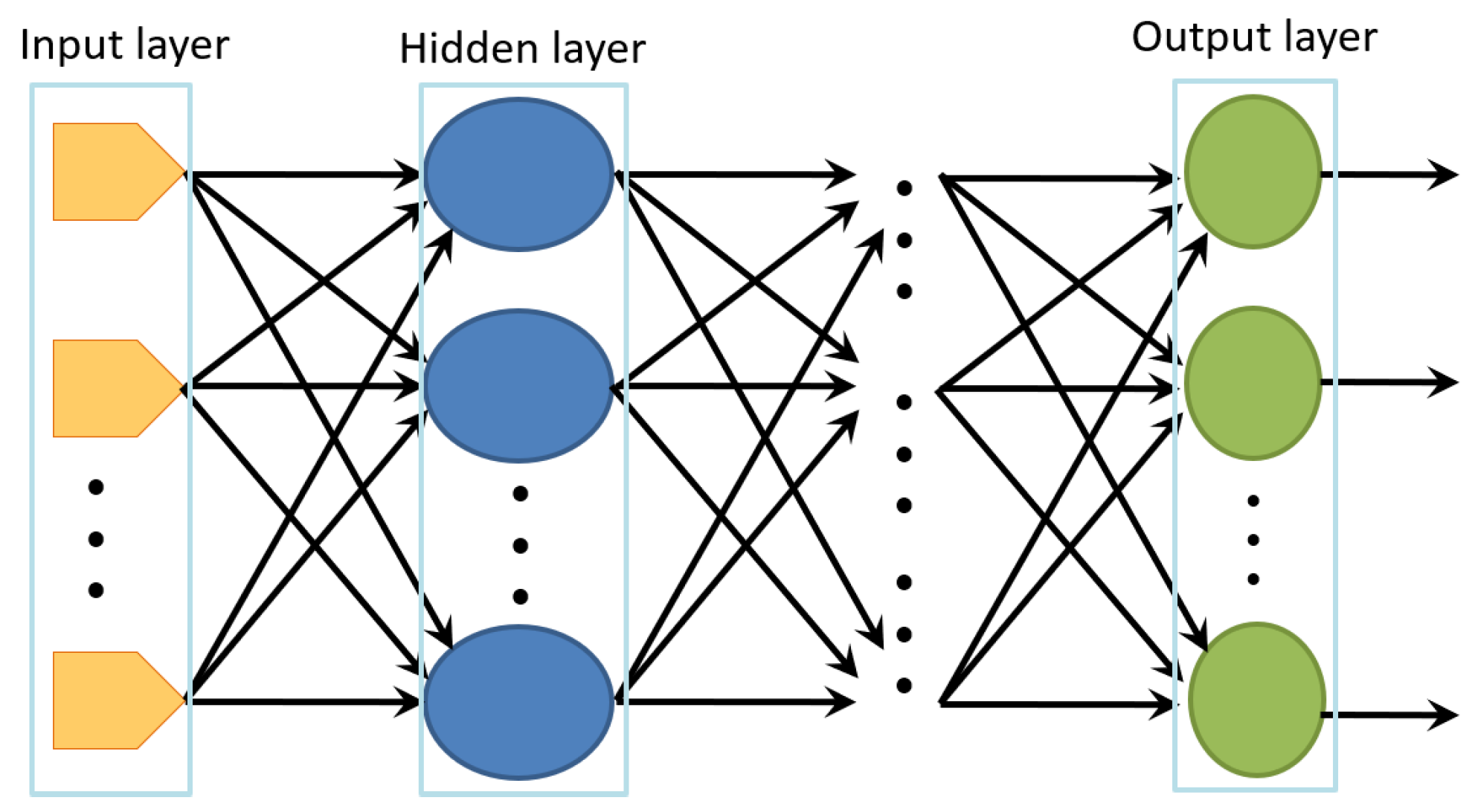

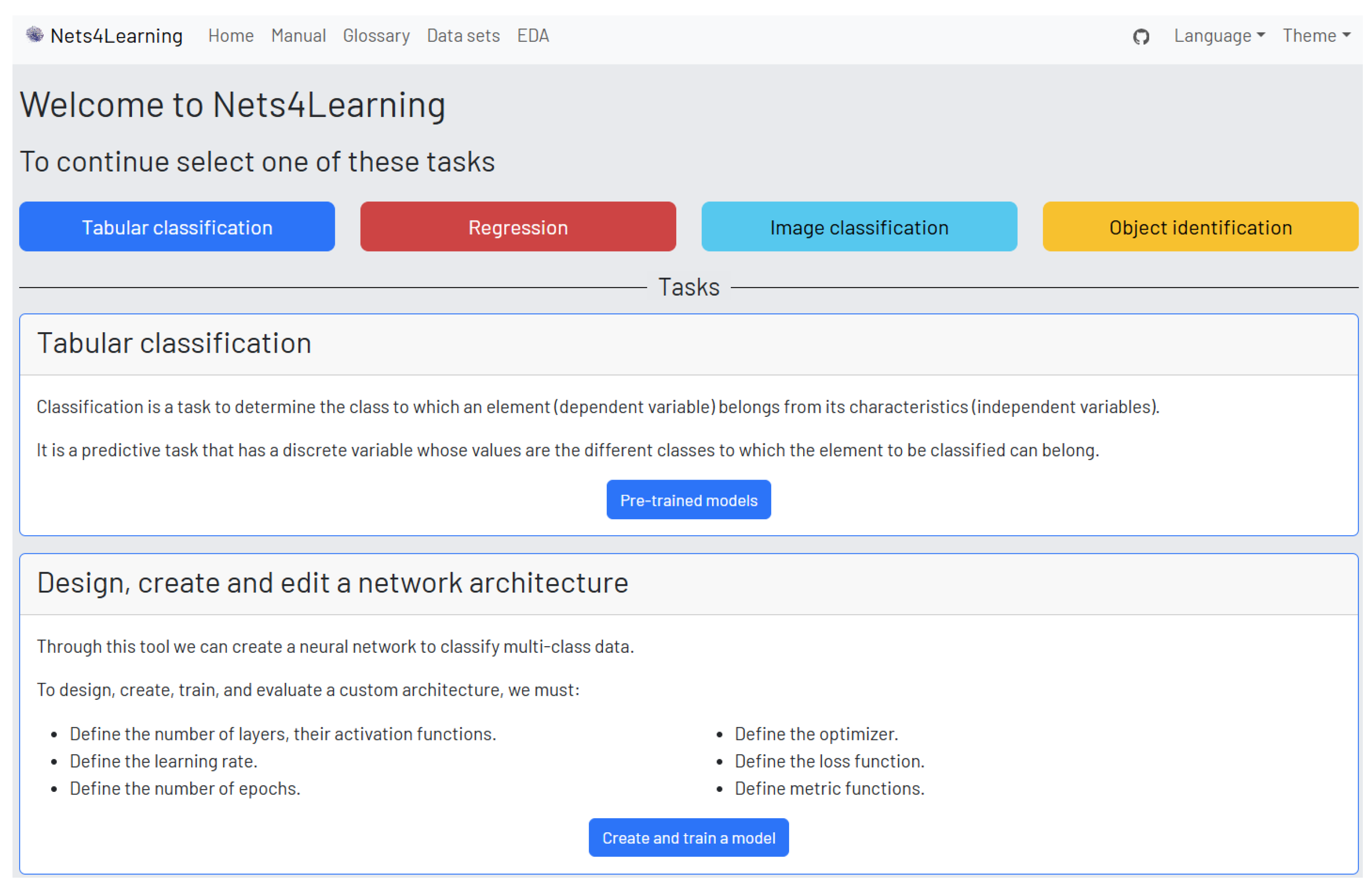
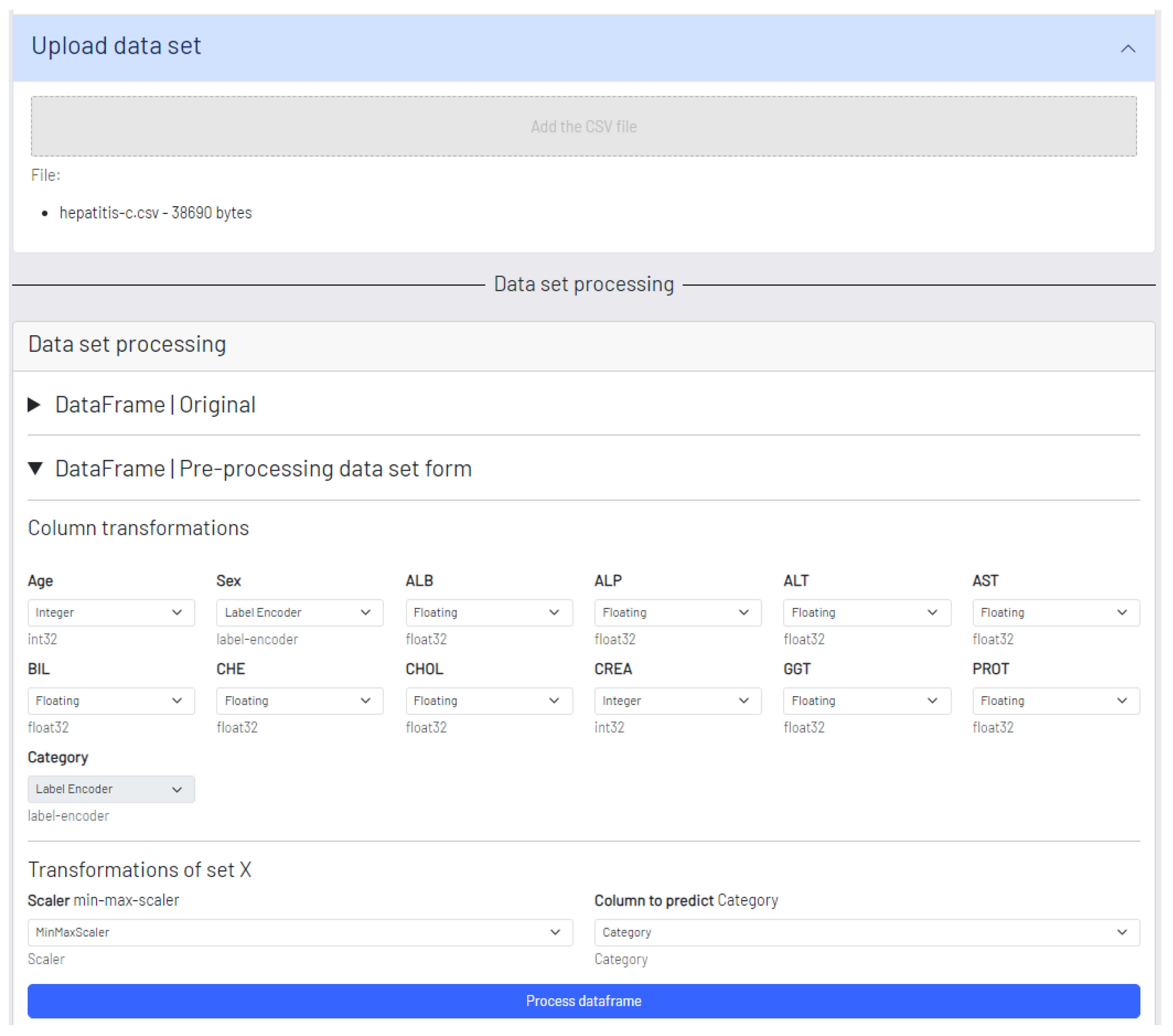
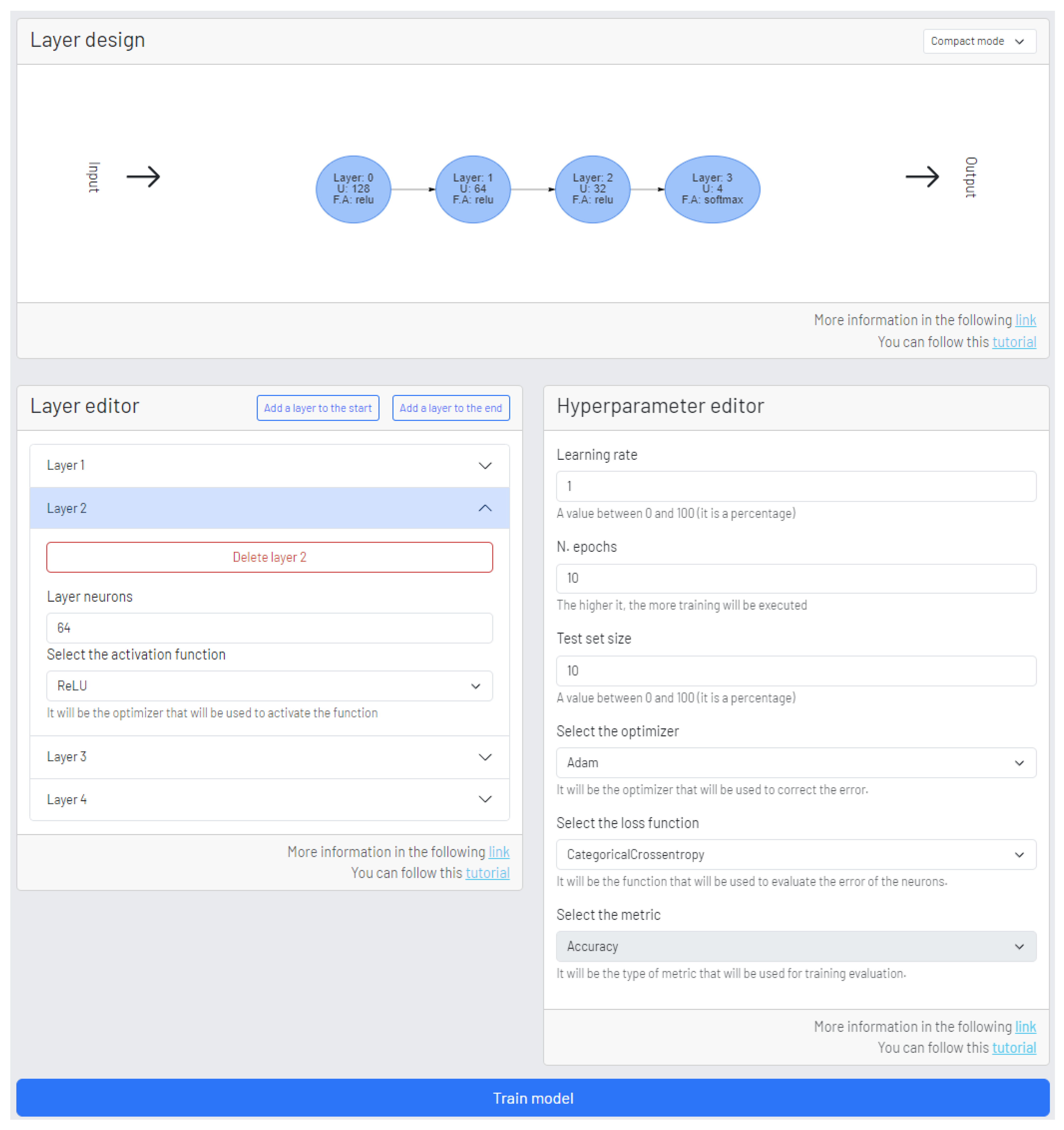
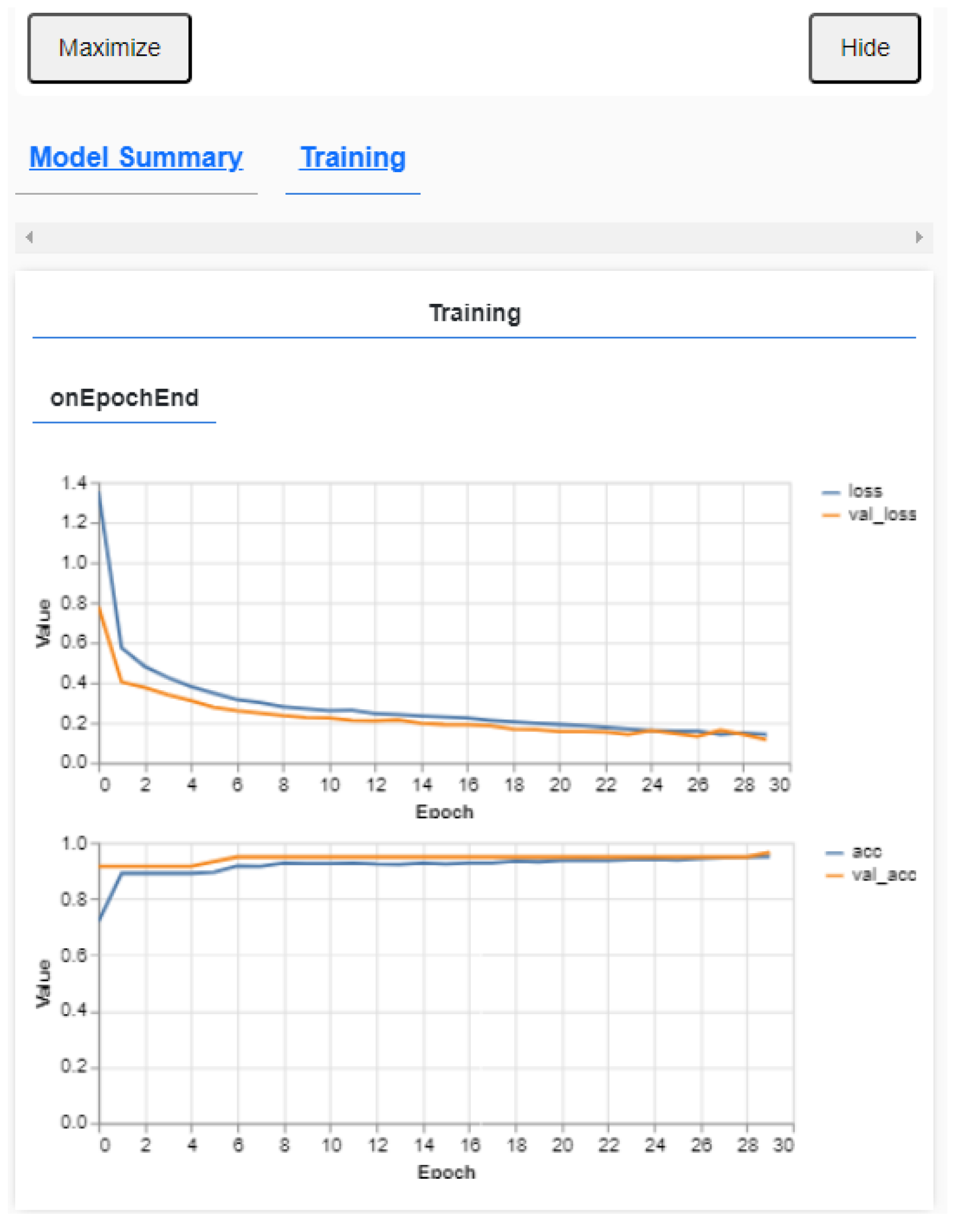
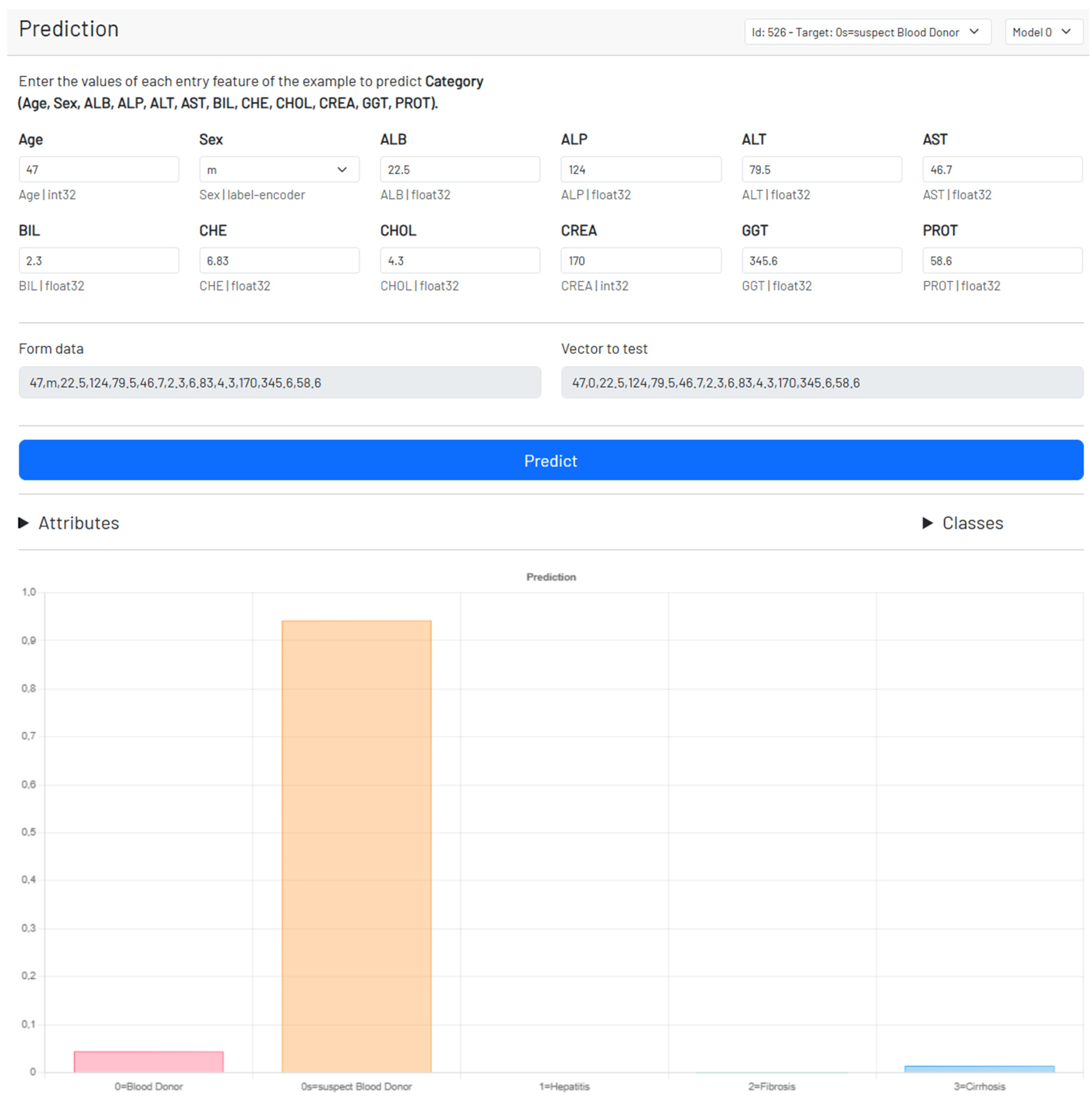
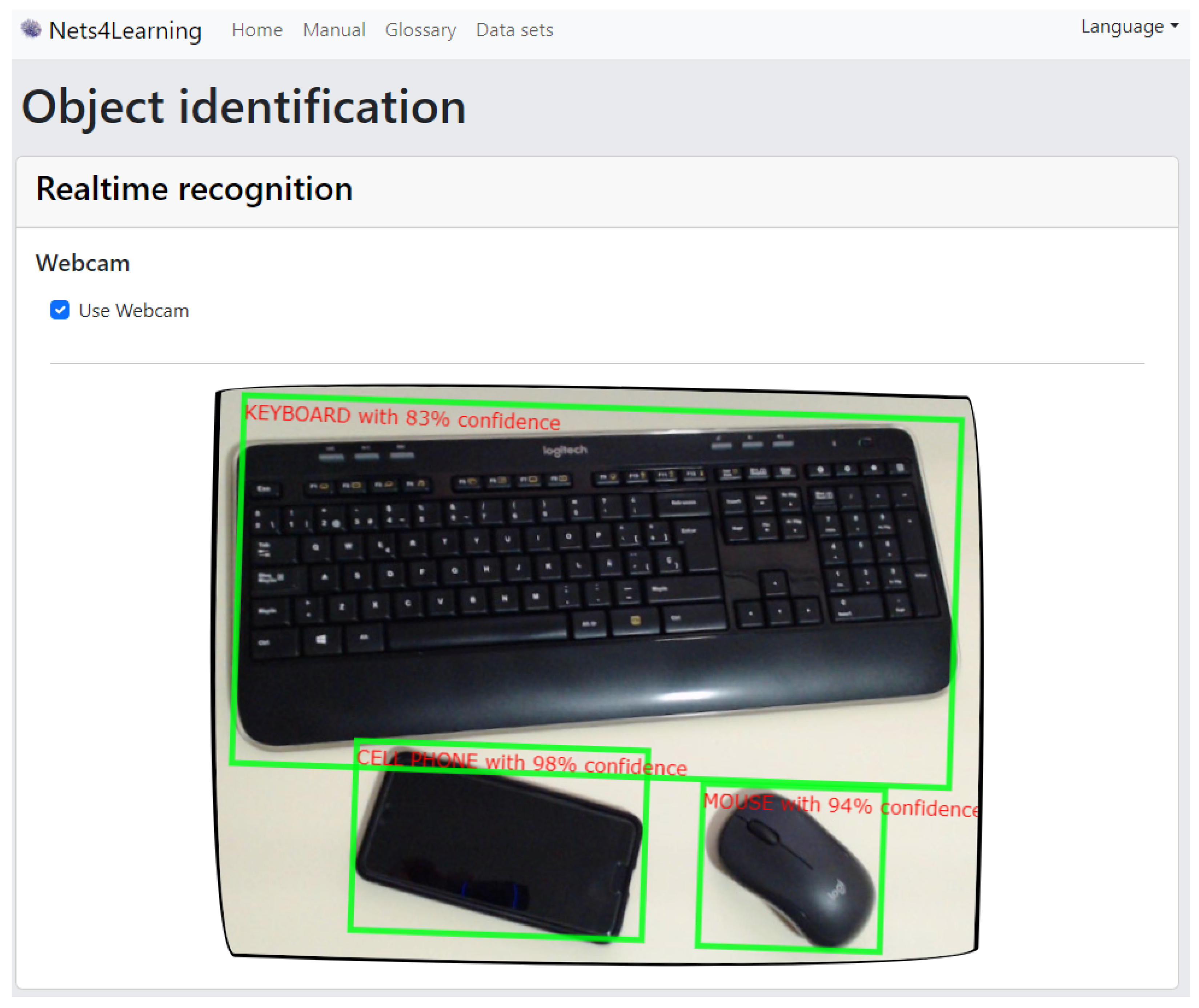
Disclaimer/Publisher’s Note: The statements, opinions and data contained in all publications are solely those of the individual author(s) and contributor(s) and not of MDPI and/or the editor(s). MDPI and/or the editor(s) disclaim responsibility for any injury to people or property resulting from any ideas, methods, instructions or products referred to in the content. |
© 2024 by the authors. Licensee MDPI, Basel, Switzerland. This article is an open access article distributed under the terms and conditions of the Creative Commons Attribution (CC BY) license (https://creativecommons.org/licenses/by/4.0/).
Share and Cite
Mudarra, A.; Valdivia, D.; Ducange, P.; Germán, M.; Rivera, A.J.; Pérez-Godoy, M.D. Nets4Learning: A Web Platform for Designing and Testing ANN/DNN Models. Electronics 2024, 13, 4378. https://doi.org/10.3390/electronics13224378
Mudarra A, Valdivia D, Ducange P, Germán M, Rivera AJ, Pérez-Godoy MD. Nets4Learning: A Web Platform for Designing and Testing ANN/DNN Models. Electronics. 2024; 13(22):4378. https://doi.org/10.3390/electronics13224378
Chicago/Turabian StyleMudarra, Antonio, David Valdivia, Pietro Ducange, Manuel Germán, Antonio J. Rivera, and M. Dolores Pérez-Godoy. 2024. "Nets4Learning: A Web Platform for Designing and Testing ANN/DNN Models" Electronics 13, no. 22: 4378. https://doi.org/10.3390/electronics13224378
APA StyleMudarra, A., Valdivia, D., Ducange, P., Germán, M., Rivera, A. J., & Pérez-Godoy, M. D. (2024). Nets4Learning: A Web Platform for Designing and Testing ANN/DNN Models. Electronics, 13(22), 4378. https://doi.org/10.3390/electronics13224378







